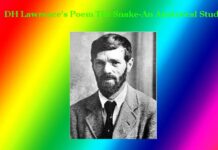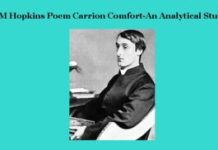Style of Walt Whitman’s Poetry
Style of Walt Whitman’s Poetry
Style of Walt Whitman’s Poetry
Generally, the word ‘style’ means the manner or fashion or mode of representing something. But in literature, the word ‘style’ indicates the manner or mode of sentences including the rhythms, prosody, cadences, figures, symbols and technique through which the matter of a piece of literature is expressed or represented. Style is not the structure; because ‘structure’ includes the way of arrangement or composition of the matter or thought of a piece of literature. But style includes the manner or way of arranging the sentences including the words employed to them through which the matter or thought is represented and thus the thought gets a body collectivity. As there are many poets and writers so there are many styles. To say discriminately the style differs from poet to poet, writer to writer and even the style of a piece of literature differs from another piece of literature of the same genre by the same author. But there are some writers whose writing styles differ apparently from that of others. Walt Whitman was an American poet who began his literary career, especially as a poet with innovation both in thought and style—which were strange and a miracle without any precedent. His style i.e. the language which includes sentences with rhyme, prosody, figures, symbols etc. was his own and own alone. Walt Whitman’s philosophy was anti-conventional and he, in everything and in every aspect of life, advocated natural freedom with natural brotherhood and mystic interpretation of life. And to invoke his natural freedom, he invented a new style of expressing his new outlook towards life as Srimanta Sankardeva of Assam who invented a new language called Bhajrabali to preach the creed and teaching of his religion i.e. Neo Vaishnavism.
Walt Whitman’s sentences are generally long, full of adjectives that run from one to another as spontaneously as the shower of rain or like the rippling of a brook. For example, we can quote the following lines:
‘‘Walt Whitman a kosmos of Manhattan the son,
Turbulent, fleshy, sensual, eating, drinking and breeding.
No sentimentalist, no stranger above men and women
or apart from them.”
Sometimes he uses so many adjectives to express the sensuous feeling that proves him that he had a skilled sway over words like Shakespeare. As for example:
‘‘Sex contains all bodies, souls
Meaning, proofs, purities, delicacies,
results, promulgations, songs, commands,
health, pride, the maternal mystery, the seminal milk.
All hopes, benefactions, bestowals all the passions,
loves, beauties, delights of the earth.
All the governments, judges, gods, followed persons
of the earth.”
In the above-quoted lines, besides the affluent use of adjectives, he has used no connective words before the adjectives.
His sentences are long and through a sentence, he tries his best to convey a single feeling completely and sometimes he achieves success, and sometimes he fails and begins another sentence to convey the same feeling.
In some of his best poems, he uses alliteration with success which imparts an extra cadence to the recitation of his poems. The poem entitled ‘Pioneer! O Pioneer!’, he makes ample use of alliteration, such as—
i. O restless, resistless race.
ii. The mighty mother mistress.
iii. We primeval forests felling.
iv. Do the feasters, gluttonous feast.
v. We the surface broad surveying.
In the composition of his sentences, there is a huge use of felicitous phrases, such as— ‘tan-faced children’, ‘Sharped-edged axes’, ‘darling blowing orb’, ‘newer mightier world’ etc.
In his writings, there are ample historical and mythological references that have made his imageries spacious. Such as—
”Cross out please those immensely overpaid accounts,
That matter of Troy and Achilles’ wrath and Aeneas’
Odysseus’ wanderings.”
Walt Whitman cares for no rhythm and prosody in arranging the words in a sentence. But yet, his sentences are full of natural cadences and inter rhymes. We can take the following sentences at random to examine how his sentences bear cadences within themselves:
i. I wander all night in my vision stepping with light feet,
swiftly and noiselessly stepping and stopping.
ii. I dream in my dream all the dreams of the other dreamers.
And I become the other dreamers.
The use of the symbol is one of the most striking features of his style. He often takes natural objects and attributes certain natures both of man and God to them and shows them in a new enlightened form. In the ‘Song of Myself’, he has attributed a mass of symbolic meaning to a piece of grass. He says:
”I guess it must be the flag of my disposition,…….
Or I guess it is the handkerchief of the Lord
………………………………………………
Or I guess the grass is itself a child
Or I guess it is a uniform hieroglyphic.”
Walt Whitman, as the quoted lines prove, desired to be an originator of a new style through which he might reveal something appealing to all universally.
In the brief to say, Whitman’s language is neither prosaic nor poetic but between the two. His language and manner of representing the sentences bear the strange and peculiar characteristics which render him peculiarity as a poet of a new order. He is strictly individual in his style. Many poets after him have come under his influence but none succeeds in imitating him completely. 0 0 0 Style of Walt Whitman’s Poetry
Style of Walt Whitman’s Poetry
N.B. The article ‘Style of Walt Whitman’s Poetry’ originally belongs to the book ‘Walt Whitman’s Poetry A Thematic Study‘ by Menonim Mennimus. Style of Walt Whitman’s Poetry











